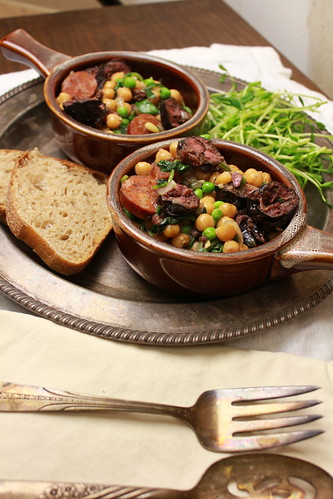
Barcelona’s La Boqueria is perhaps the most famous food market in the world, and the most famous of its bar/restaurants is undoubtedly Pinotxo (pee-not-cho), run by the equally famous Juanito Bayen. His immaculate sense of dress and reputation for treating his guests like family have made him and his 14-stool establishment legendary. Indeed, such is his generous spirit that many are the tales of him spontaneously breaking open magnums of pink cava at 11am and passing glasses around. Everyone in the know food-wise, it seems, has made a bee-line for his place when passing through Barcelona on their way to other notable establishments like El Celler de Can Roca and Albert Adria’s Bodega 1900. Everyone, that is, except us. In fact, during our visit to Barcelona, we didn’t even make it to La Boqueria, in spite of staying about three hundred yards away down Las Ramblas, and we must have walked past it more than a few times as we explored the city.
If this makes us bad foodies, then that’s something we’re going to have to live with until such a time as finances and children allow us to return. To be fair, the same is also true of London’s storied Borough Market. Although in its case, I was a resident of London for three years so the circumstances are less extenuating. That is, unless one considers it within the context of the absolute penury which living in London in my early twenties reduced me to. As such, my unwillingness to put myself through the anguish of gawping at a sea of unattainable comestibles as I jangled hard-earned coppers in my threadbare pockets may be understood.
Almost as famous as Bayen’s bowtie and broad smile are the impeccable Catalan dishes turned out of a kitchen no larger than a shower stall by his nephew Albert Asin. Taking inspiration from the bounty available on the surrounding market stalls, Asin’s cooking takes advantage of La Boqueria’s world-class produce and seafood: red prawns a la plancha from Palamos dusted with sel de Guerande, soupy rice dishes from Catalunya’s lower camp near Tarragona jam-packed with bosky wild mushrooms or delicate cigalas, and, in winter, a stunning dish of crumbled butifarra negra, black sausage, with chick peas in the Catalan style.
We may not have visited La Boqueria or any of the other aforementioned restaurants during our visit but we did make sure to consume our fair share of butifarra, both white and black, so it was that when we spied a recipe from Pinotxo while reviewing the new book Charcuteria – The Soul of Spain it seemed an appropriate way of making up for having missed out on Pinotxo during our visit.
The dish, as we made it — and it should be noted that we used Jeffrey Weiss’ recipe more as an inspiration than a recipe — is more or less a quick stove-top stew since we took the liberty of using canned chickpeas rather than dried, used a Portuguese morcilla we had brought back from Montreal and added two chorizos to the ingredient list. Eaten in the early spring, with wintry sausage and beans rubbing shoulders with young, fresh peas and watercress, it was as good on a cool, rainy day as the bright, warm one that followed. With the contrast of the black sausage, the sandy chickpeas, the auburn chorizo, and the emerald peas; the variety of textures, and the minerality and sweetness of the morcilla — it’s a whole lot packed into a single dish, reflecting perfectly Asin’s tiny kitchen and Pinotxo’s elbow-to-elbow conviviality.
Adapted from Jeffrey Weiss’ Charcuteria – The Soul of Spain
(feeds 2 hungry adults as a main or 4 as a tapa with bread)
Note: butifarra negra is more similar to a French boudin noir than to a typical Spanish morcilla in that it can be crumbled on account of it containing diced pork colored/flavored with blood rather than predominantly blood coagulated around grains. If you have butifarra type sausage then by all means crumble it rather than slicing the morcilla as we did. And depending on the texture of your morcilla, we would recommend cooking it separately first before slicing otherwise it may well just fall apart.
Ingredients:
- 1 x 16oz can of chickpeas, undrained.
- 1 x 8oz link of blood sausage (morcilla, boudin noir, butifarra negra), cut into 1/4 inch slices
- 2 x small chorizos (or 1 larger one), cut into 1/4 inch slices
- 1/2 medium onion, diced
- 2-4 cloves garlic, finely chopped
- 4-6oz fresh or frozen peas
- 2 good handfuls of watercress
- 2 tablespoons pine nuts
- 2 tablespoons golden raisins/sultanas
- 1 tablespoon good olive oil
- 1 tablespoon Oloroso sherry (sweet Marsala will also work in a pinch)
- salt and black pepper
Recipe:
- In a bowl, soak golden raisins/sultanas in the sherry for up to an hour until they are nicely plump.
- In a large saucepan over medium heat, sweat the onion in the olive oil until translucent.
- Add blood sausage and chorizo and cook for a couple of minutes until edges/skins become slightly crispy.
- Add garlic and cook until fragrant – 1-2 mins
- Strain golden raisins/sultanas from sherry, and deglaze pan with it, stirring well to scrape up good stuff from bottom of pan.
- After another two minutes, add chickpeas/garbanzos with canning liquid and stir well.
- Add frozen peas and watercress. Cook another 1-2 minutes until they’re cooked/wilted but still bright green.
- Add pine nuts and golden raisins/sultanas and stir well.
- You should have a dish that isn’t very saucy but not totally dry either.
- Taste and correct seasoning with salt and pepper.
- Serve with chilled cava or a bone-dry fino sherry.


I loved La Boqueria, but I completely understand not wanting to go there on account of not having a kitchen readily available to cook the amazing food available for purchase. To be honest, trying to get a spot at any of the bars there is also quite difficult, but I think the key is going there early-ish on weekday mornings and avoiding the place completely on Saturdays. And it’s worth the visit even if cooking isn’t possible, because along with places like Camp Nou, it feels like an epicenter of sorts of Catalunya. It’s been a while since I’ve had good blood sausage–I’ll have to get some the next time I’m in the city and try this while there’s still enough of a chill in the air.
@Elizabeth: perhaps it is best we didn’t make to La Boqueria then, as we definitely had nowhere to cook anything. Agree with you that the Camp Nou, among other Barcelona attractions, is a locus for Catalonian-ism now and historically, mes que un club, etc. What is great though is that we can always go back and check it out more at our leisure since, Montjuic apart, we hammered Barcelona on foot during that trip.
Aloha! My husband and I will be in Barcelona next month for a week, WITH a kitchen this time–(although the last time we went I didn’t mind eating mussels every day in a different restaurant, etc..) and this recipe is coming with me. It looks superb. Thanks. (p.s. nice Marquez reference–will miss him)
@Deb: welcome back! It’s been a while. Hope you have a fantastic trip to Barcelona and make sure to pack your eating pants! I think everyone will miss Garcia Marquez but not everyone knows that yet. I felt the same way when Borges died.
Hi there, we’re back and I’m happy to report that I DID make this recipe, IN Barcelona, and although it was good, the best part was shopping for the ingredients at La Boqueria. Watercress was a challenge, but only because they of course call it something else. What I found was much peppier version than I’m used to and like much better, esp. in this dish. All the ingredients seemed a bit “confusing” at first, but second day was much better, and third day for breakfast with a fried egg on top was best! I can send you pics if you want, let me know, and thanks for this recipe. Pinotxo was closed by the time we went to the market but we caught a seafood bar right before it closed and tried about 7 different small plates of octopus, mussels, clams, etc…You get the picture. Oh boy, we ate well.
Deb
P.S. The place we stayed in would be perfect for a couple with kids (hint hint) so if you want I’ll send you info. Right across from the marina.
@Deb: sounds like a wonderful trip! So glad you enjoyed it and made this dish there. Te leftovers are pretty spectacular, aren’t they? Please do send us the info about the place you stayed, we may be back there yet!
Hey there—I sent the info to your email address which I HOPE is still the correct one—along with pics of my stew—and yes, the leftovers were spectacular–
P.S. I’m always looking for good–or even bad–substitutes for “awesome”…Gawd save us from that word…Spectacular is a good one! thanks..
@Deb: thanks so much! You did a great job with the stew – it looks even better with the fried egg. You’ve made us very nostalgic about being in Barcelona and itchy to hit the road again!
You are very welcome, I love sharing travel info–and May The Itch Be With You…forever!!